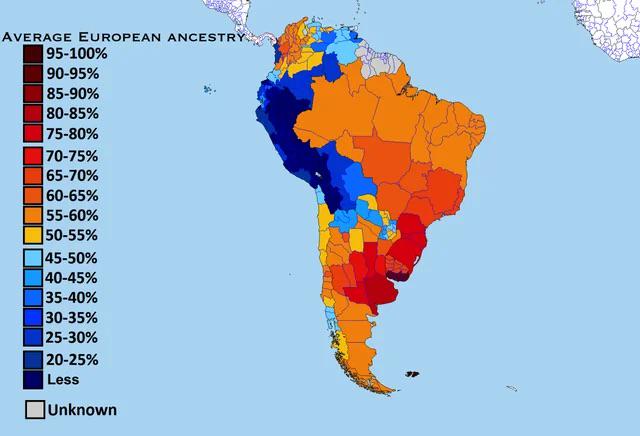Average European Ancestry in South America Map


David Chen
Data Visualization Specialist
David Chen is an expert in transforming complex geographic datasets into compelling visual narratives. He combines his background in computer science ...
Geographic Analysis
What This Map Shows
The "Average European Ancestry in South America Map" provides a detailed visualization of the genetic heritage found across various regions in South America, specifically highlighting the proportion of European ancestry within the populations. This fascinating map uses genetic data to illustrate how historical migration and colonization have shaped the genetic landscape of the continent. By indicating the percentage of European ancestry in different countries and regions, it offers valuable insights into the demographic and cultural influences that have persisted over centuries.
Deep Dive into European Ancestry in South America
The presence of European ancestry in South America is a direct result of the significant migration that occurred during the Age of Exploration and subsequent colonial periods. This migration was primarily driven by the Spanish and Portuguese, whose explorers and settlers established colonies throughout the continent. Interestingly, the genetic makeup of South American populations is a complex tapestry woven from indigenous, African, and European ancestries.
According to genetic studies, European ancestry in South America averages around 30-45% in various regions, with notable variations. For instance, countries like Argentina and Uruguay exhibit higher percentages, often exceeding 60%, due to extensive European immigration during the 19th and early 20th centuries. In contrast, nations like Bolivia and Peru show lower European ancestry, often between 10-20%, reflecting a stronger indigenous presence.
The impact of this European ancestry is multifaceted. It influences cultural practices, language, and even social structures. In urban centers like Buenos Aires, the European influence is palpable in the architecture, cuisine, and lifestyle, showcasing a blend of cultures that have evolved over generations. Have you ever noticed how the tango dance has both African and European roots? This reflects the intermingling of different ancestries that created distinctive cultural expressions.
Additionally, genetic studies reveal that the European ancestry in South America is not uniform. The map highlights significant regional differences, with areas near the Atlantic coast generally showing higher European ancestry due to historical settlement patterns. In contrast, Andean regions, where indigenous populations were less affected by European settlement, reveal a more considerable proportion of Amerindian ancestry. This regional disparity underscores the historical complexities of colonization and migration.
Regional Analysis
When examining the map closely, several distinct regions in South America stand out based on their European ancestry levels.
1. **Southern Cone (Argentina, Chile, Uruguay)**: This region boasts the highest average European ancestry, primarily due to substantial 19th-century immigration from Europe. Argentina, in particular, has a rich European heritage, with over 60% of its ancestry traced back to Europe. This has led to a predominantly European cultural influence, seen in everything from cuisine to language.
2. **Brazil**: While Brazil presents a diverse genetic landscape, the southeastern part, especially São Paulo and Rio de Janeiro, shows considerable European ancestry, often around 50%. However, the north and northeast regions reveal a more considerable African and indigenous ancestry, reflecting Brazil's complex history of colonization and the slave trade.
3. **Andean Countries (Peru, Bolivia, Ecuador)**: Here, European ancestry averages lower than in the Southern Cone, often ranging from 10-20%. The significant indigenous populations in these countries contribute to this lower percentage, highlighting the historical dynamics of colonization and the resilience of indigenous cultures.
4. **Venezuela and Colombia**: These countries present a mixed scenario with varying degrees of European ancestry. Colombia, particularly, has regions with high European influence, especially in cities like Bogotá, whereas rural areas may still reflect a significant indigenous heritage.
Significance and Impact
Understanding the average European ancestry in South America is essential for several reasons. First, it sheds light on the continent's cultural diversity, revealing how history has shaped identities and social structures. Furthermore, as globalization continues to influence migration patterns, the genetic landscape of South America may evolve, leading to more intricate blends of ancestry.
Interestingly, this topic also plays a vital role in discussions about race, identity, and social justice in South America. The historical context of European colonization often intertwines with contemporary issues regarding inequality, representation, and cultural heritage. As societies grapple with these topics, understanding ancestry can provide a clearer picture of current social dynamics.
In conclusion, the Average European Ancestry in South America Map is not just a tool for visualizing genetic data; it's a gateway into understanding the rich, complex history of the continent. As we continue to study these patterns, we can anticipate shifts in demographic trends and cultural expressions that will shape South America's future.
Visualization Details
- Published
- October 27, 2025
- Views
- 16
Comments
Loading comments...